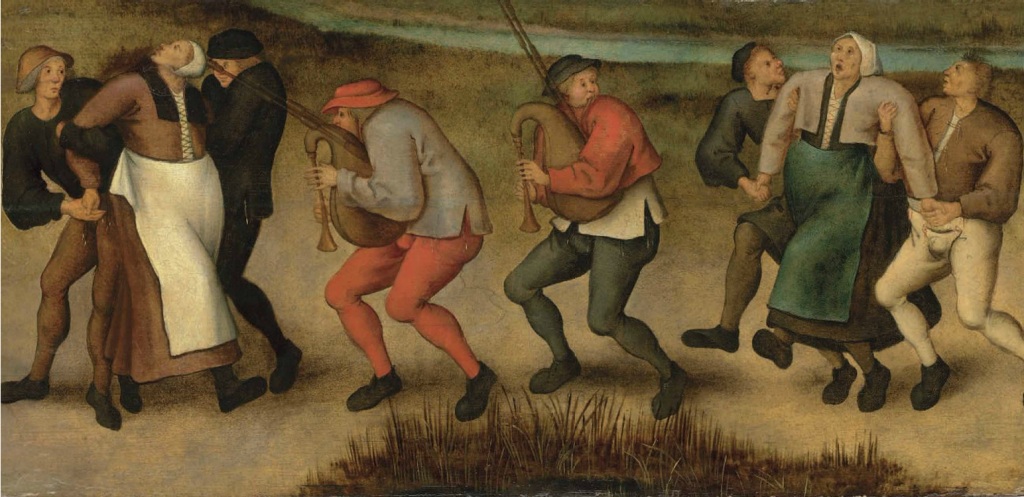by Jarrett Hoffman

•Today: a lecture on improvisation at Oberlin Baroque Performance Institute and a recital by Nigel North (pictured) at Cleveland Lute Fest
•Announcements: a webinar on analytics for organizations in the area, an arts & culture networking event, and extended auditions from Cleveland Orchestra Youth Orchestra
•Almanac: “The Fatal Dance Manias of Medieval Europe”
HAPPENING TODAY:
As part of the Oberlin Baroque Performance Institute, violinist Edwin Huizinga and harpsichordist Mark Edwards will give a lecture/demonstration titled “Introduction to Improvisation” at 2:00 pm at Oberlin Conservatory’s Kulas Recital Hall. It’s free.
And Cleveland Lute Fest will present lutenist Nigel North in a program of German Renaissance music at 7:30 pm at Case Western’s Harkness Chapel. Tickets can be purchased at the door.
ANNOUNCEMENTS:
Cuyahoga Arts & Culture invites organizations in the area to make use of a webinar titled “Data at Work: Introduction to DataArts Analytic Tools,” to be presented on Tuesday, July 25 at 12:00 pm. Produced in partnership with SMU DataArts, the webinar will cover sector-wide trends and the basics of running analytic reports on your data. Learn more and register here.
Assembly for the Arts will host an Arts & Culture Network Night on Wednesday, June 26 from 6-8 pm at The Brownhoist in Cleveland. The event includes a performance by multidisciplinary artist and activist Vince Robinson, and Ahlon Gonzalez (LAND Studio project manager and Creative Activism Consultant of Cleveland VOTES) will serve as guest speaker.
The Cleveland Orchestra Youth Orchestra has extended the audition window for French horn, bass, viola, and percussion. Apply here. Questions can be emailed to Kennedy McKain.
TODAY’S ALMANAC:
There are dance traumas — eighth-grade formal, senior prom.
There are dance crazes — the Charleston, the Moonwalk, Gangnam Style.
And then there’s what happened on this date in 1374 in Aachen, Germany.
As Wendy Graham writes in an article for On This Day titled “The Fatal Dance Manias of Medieval Europe,” individuals began dancing — and simply could not stop.
“Accounts say the dancers hardly paused to eat or sleep…they were described as grimacing, exhausted and often in pain, and they shook and twitched as they continued to dance.” Some considered the affliction a curse bestowed upon them by Saint John the Baptist. Thus it became known as Saint John’s Dance — and it spread to cities such as Liege, Utrecht, and Tongres.
(Above: an anonymous painting based on a drawing by Peter Breughel depicting another dance epidemic.)
Music, as it turned out, was not the best medicine.
That much is clear from the similar Saint Vitus’ Dance, which took hold in Strasbourg in 1518. In this case the city council hoped that the dancers simply needed to get things out of their system, and so, acting on the advice of physicians, encouraged the afflicted to just keep going.
As Ned Pennant-Rea writes in the essay “The Dancing Plague of 1518” for The Public Domain Review:
Carpenters and tanners were ordered to transform their guild halls into temporary dance floors…dozens of musicians were paid to play drums, fiddles, pipes, and horns, with healthy dancers brought in for further encouragement.
This very public display of the affliction only seemed to further its spread. As the author of the essay notes, “Being more inclined to a supernatural than a medical explanation of the dance, most of the onlookers saw in the frenzied movements a demonstration of the magnitude of Saint Vitus’ fury. None being free of sin, many were lured into the mania.”
The council reversed course, instituting a temporary ban on almost all music and dance in the city. They did make an exception, and a very reasonable one. As recorded by a 15th-century politician of Strasbourg, “If honourable persons wish to dance at weddings or celebrations of first Mass in their houses, they may do so using stringed instruments, but they are on their conscience not to use tambourines and drums.”
The council also sent those afflicted to the shrine of Saint Vitus, where they were put through a ritual involving crosses, red shoes, holy water, incense, and incantations. In this way they hoped to receive the patron saint’s forgiveness, and indeed the affliction did subside. But not before it had claimed the lives of what may have added up to hundreds of people.
So what was actually behind this strange illness? Many reasons have been thought up over the years. The most widely accepted one today attributes the mania to severe hardship and anguish brought on by “a string of bad harvests, political instability, and the arrival of syphilis” — combined with the particular religious beliefs prevalent in these societies.
You might be wondering what those of us in the present day can take away from these events. First, it is advisable to know the location of the nearest shrine of your preferred saint, even when traveling. Second, avoid viewing any public displays of dance or indeed any bodily movements — the mind is far too suggestible. And third, stay vigilant to help prevent any occurrences of bad harvests, political instability, syphilis, and percussion.
We can all only try our best.



